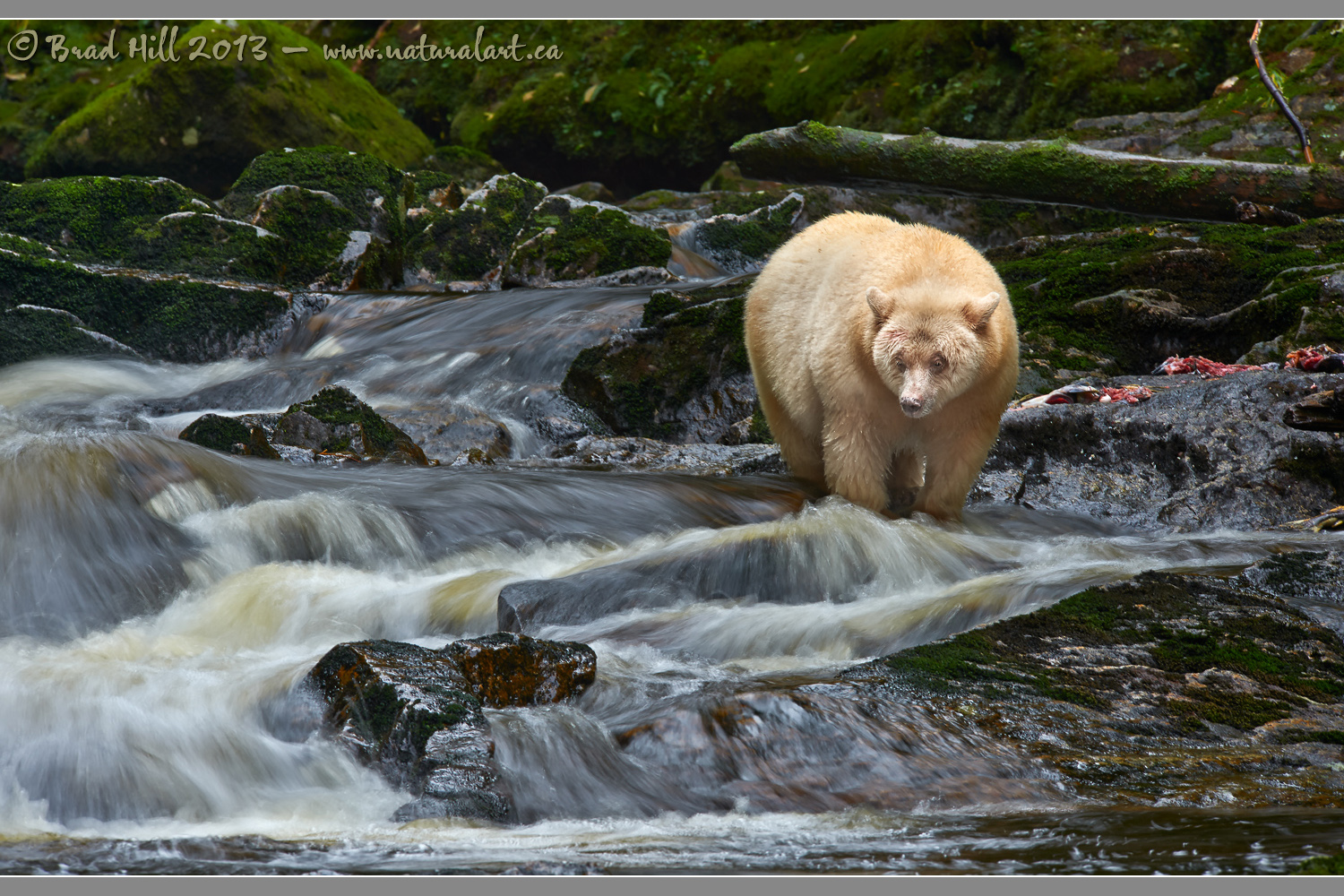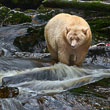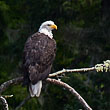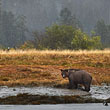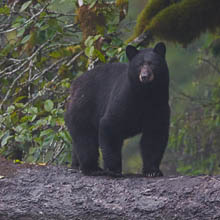Availability: Limited Edition Print - info coming soon!
In the Field
Spirit Bear - Patience. Gitga'at Traditional Territory, Great Bear Rainforest, BC, Canada. October 3, 2013.
I captured this image of a rare white Spirit Bear in a location in the Great Bear Rainforest that is normally off-limits to visitors - our access to the area was solely courtesy of the generosity of representatives of the Gitga'at First Nations - my thanks are whole-heartedly extended for granting us this rare privilege!
Every organism found in the world's largest intact tract of temperate rainforest (yep, the Great Bear Rainforest) - from the towering trees down to the birds, squirrels, and even microorganisms - is inextricably linked to the annual nutrient and energy input of millions of migrating and spawning salmon. When it comes to the bears, the salmon are absolutely critical to reproduction: in years when the salmon numbers are high - and the bears are well-fed before going into hibernation - the pregnant female bears take their pregnancies to full term and cub mortality is low. In years when salmon numbers are low (which is happening increasingly frequently) and female bears go into hibernation with a slightly lower amount of body fat and they will actually spontaneously abort their pregnancy (i.e., resort their embryos). Put enough "bad" salmon years together and the long-term reproductive rate - and the number of bears in the woods - can start dropping fast. If your total population size numbers in the hundreds - like it does with Spirit Bears - this can lead to a disastrous results fast.
So...when one encounters a very rotund and almost roly-poly female Spirit Bear in a stream chock-full of pink salmon in mid-October - along with blood-red evidence of her recent success at fishing - it's very encouraging and uplifting. And, if you happen to be a wildlife photographer, it's even more exciting - it's a completely "off-the-charts" moment! ;-)
But back to the image itself. This is the same bear I used to create the animalscape* shot entitled "The Great Bear Gauntlet" that has proven to be quite popular (view it here on my website or here on NPN). In the shot above the bear had moved further upstream, and I decided to grab a considerably longer lens and move in tighter - including only the bear and a select few key elements in the frame (i.e., a bear plus its immediate environment - what I often refer to as an "enviroscape"). I liked the diagonal flow added by the flowing water and the "depth" of the scene.
I faced two creative decisions affecting how I wanted to convey the scene. These two decisions were independent creatively, but in technical terms they are tightly tied together. The first was the Depth of Field (DoF). The only way I could see this image working was to choose a DoF where almost the entire frame was in sharp focus - though I wasn't too worried about the distant background being sharp. But I wanted the bear, all the flowing water, and the rocks and ledge in the foreground to be rendered quite sharply - with no distracting "bands of focus" and especially no "globular" out-of-focus objects in the foreground. Given I was using a 400mm lens, this meant stopping way down...
Decision two? How to render the water. There's no real way to render flowing water in a still photograph exactly the way we see it in the field. Pick a high shutter speed and you "freeze" the water's motion - and it ends up appearing harsh - sometimes very harsh. Pick a very slow shutter speed (e.g., 2 or more seconds) and the water can appear incredibly "silky". But neither the harsh look or the "uber-smooth and silky" look very close to what one sees in the field. Given my need to stop down, the ISO range I knew I could work with, and the optional use of a circular polarizing filter, despite the relatively low light I had a fairly wide range of shutter speeds I could select from - about 1/160s down to 2.0 seconds.
My gut said this: "Stop way down, go real low ISO, lose the circular polarizer, and go with a shutter speed that's slow but not too slow - make the water smooth and flowing, but not totally silky." In the end I ended shooting 173 shots of this scene, including some at shutter speeds higher than 1/100s, some at shutter speeds longer than 2.5s (with circular polarizer on), but with the majority of them (107 actually) at between 1/10s and 1 second. Of course, MANY of the 107 "slowish" shutter speed shots were totally ruined by the bear moving (like 95 of 107!). Of the 173 shots, this image is one of my two favorites.
And I'll let YOU decide exactly who the word "Patience" in the image title refers to - to me or to the fishing bear! ;-)
This is one of those images where "the devil is in the details" - which you can only really see in a higher resolution version. So here ya go:
• Spirit Bear - Patience: Download 2400 pixel image (JPEG: 2.0 MB)
ADDITIONAL NOTES:
1. This image - in all resolutions - is protected by copyright. I'm fine with personal uses of it (including use as desktop backgrounds or screensavers on your own computer), but unauthorized commercial use of the image is prohibited by law. Thanks in advance for respecting my copyright!
2. Like all wildlife photographs on this website, this image was captured following the strict ethical guidelines described in The Wildlife FIRST! Principles of Photographer Conduct. I encourage all wildlife photographers to always put the welfare of their subjects above the value of their photographs.
3. This image was captured during one of my "Into the Great Bear Rainforest" photo tours during the autumn of 2013. Each year I offer trips into two different parts of the Great Bear Rainforest as well as one to photograph aquatic mammals and oceanscapes near the northern tip of Vancouver Island. And, in selected years, I also offer photo tours to locations to capture other highly sought-after subjects, such as various owl species of the boreal forest and wildlife of Canada's Arctic. Details about these trips can be found on the Photo Tours page of this website.
*4. For a more detailed discussion of the image types I call animalscapes and enviroscapes (and the subtle distinctions between them), just go here...
Behind the Camera
Spirit Bear - Patience. Gitga'at Traditional Territory, Great Bear Rainforest, BC, Canada. October 3, 2013.
Digital Capture; Compressed RAW (NEF) 14-bit format; ISO 100.
Nikon D4 paired with Nikkor 400mm f2.8 VR lens. Tripod mounted (Gitzo 1348 carbon fiber tripod with Wimberley II gimbal head). VR OFF. Live View mode (i.e., mirror up) and cable release.
1/5s @ f16; -0.33 stop exposure compensation from matrix-metered exposure setting.
At the Computer
Spirit Bear - Patience. Gitga'at Traditional Territory, Great Bear Rainforest, BC, Canada. October 3, 2013.
RAW Conversion to 16-bit TIFF, including first-pass/capture sharpening using Capture One Pro version 7. Four raw variants (different versions of a single raw capture) differing by a total of 1.5 stops in total exposure.
Further digital corrections on resulting 16-bit TIFF files using Adobe's Photoshop CC and Light Craft's LightZone. Photoshop adjustments included compositing (blending) of the four exposure variants, minor selective colour saturation and desaturation, selective contrast adjustment to the water (via two selective curves adjustment layers) and sharpening for web output. Final tone tweaking performed using tonemapper/re-light tool in LightZone.
Conservation
Spirit Bear - Patience. Gitga'at Traditional Territory, Great Bear Rainforest, BC, Canada. October 3, 2013.
Ten percent of the revenue generated by this image will be donated to Raincoast*.
Species Status in Canada**: Not currently listed as Threatened or Endangered.
The "Spirit" Bear is a rare genetically-based colour variant of the common Black Bear (Ursus americana). It has been estimated that less than 300 Spirit Bears exist today. Because the Black Bear is not considered under threat as a species, the Spirit Bear suffers from having the same conservation designation (it should be acknowledged that in British Columbia - the jurisdiction of greatest Spirit Bear abundance - hunting of these white-coated bears is not permitted). For reasons that are not fully understood, the Spirit Bear occurs with greater frequency in a relatively small geographic area within The Great Bear Rainforest of the central and northern coast of British Columbia. In this area 10 to 30% of the bears possess white coats. Many of the black-coloured Black Bears in this region carry the gene for white coats, so allowing hunting of ANY Black Bears in this region can reduce the frequency of the gene for white coats. Thus, to protect the Spirit Bear, it is necessary to prohibit the hunting of ALL Black Bears in this region. And, very unfortunately, the globally unique ecosystem that contains the Spirit Bear is under development pressure, especially from the forestry industry. If this unique environment is altered, we may lose the wonderful genetic anomaly known as the Spirit Bear forever.
The region this image was shot in is, at the time of this writing (November 25, 2013), facing a new and potentially catastrophic threat. There is a proposal to bring oil super-tankers through the narrow and treacherous channels of the Great Bear Rainforest. Any mishap - such as the one that sunk the Queen of the North ferry on March 22, 2006 - could result in an oilspill with disastrous consequences.
*The Raincoast Conservation Society (and Foundation) is an effective and efficient organization that has been fighting for protection of this unique habitat. If you are looking for a meaningful way to contribute to the conservation of this amazing ecosystem, Raincoast will provide maximal "bang" for your conservation dollars.
**as determined by COSEWIC: The Committee on the Status of Endangered Wildlife in Canada













